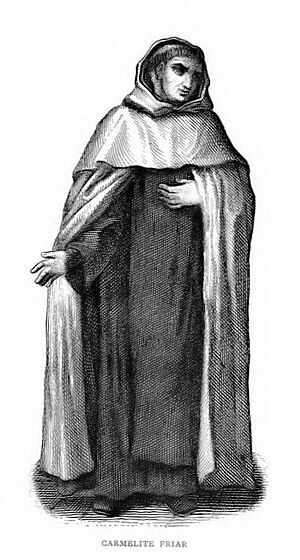William of Littlington facts for kids
William of Littlington was an English friar. He was also known as William of Ludlington. He lived a long time ago, around the early 1300s. William was a Carmelite friar, which is a type of monk. He was also a writer who studied religion. He went to Oxford University and became a Doctor of Theology. This means he was very knowledgeable about religious studies.
Contents
William's Early Life
William was born in England. Some historians think he was from Lindsey. Others believe he came from Littlington in Cambridgeshire. Another idea is that his last name came from Lyddington.
He likely joined the Carmelite Order in Stamford. This town is close to Lyddington. The Carmelites are a religious group of friars.
Becoming a Doctor of Theology
William studied at the University of Oxford. By the year 1301, he earned a special degree. He became a Doctor of Theology. This showed he was a very skilled scholar.
William's Role as a Leader
William became a leader in the Carmelite Order. He took over after Henry de Hanna died in 1300. This made him the head of the Carmelite group in England.
A Disagreement and Its Consequences
In 1303, a big meeting happened in Narbonne. It was called the Council of Narbonne. At this meeting, a leader named Gerard of Bologna wanted to split the Carmelites. He wanted to make Ireland and Scotland a separate group from England.
William of Littlington did not agree with this plan. He spoke out against it. Because of his opposition, he was removed from his leadership role. He was also told to do a four-year penance. This meant he had to fast and study religious texts. He spent this time teaching in Paris, France.
New Leadership in Faraway Lands
After his penance, William was given a new job. In 1309, another meeting happened in Genoa. At this meeting, William was made a leader. He became the provincial of the Carmelite Order in the Holy Land and Cyprus. These are places far away from England.
William's Later Years and Writings
William of Littlington passed away around 1310 or 1312. He died at the Carmelite friary in Stamford. He was also buried there.
Surviving Works
William wrote several books and commentaries. A commentary is a book that explains another book. One of his important works is a Commentary on St. Matthew. This book explains the Gospel of Matthew from the Bible.
This commentary can still be found today. It is kept at New College, Oxford. Other writings by William are mentioned by old historians. However, these other works are not known to exist anymore.


